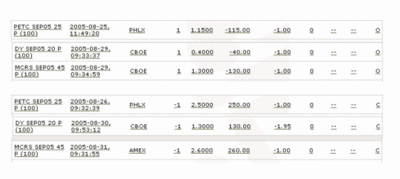It's important to build a strong foundation of your options trading knowledge before you invest your real, hard-earned money in options trading. I've benefited a lot from the options knowledge & skills learned in the "Options 101 Home Study Course" before I attended the Live Freely Seminar.
The "Options 101 Home Study Course" was created by Mr Ron Ianieri, a former Options Trading Specialist, Floor Trader and Market Maker, is without a doubt one of the most seasoned and highly skilled options traders in the industry. He has mentored and coached some of the most successful Wall Street traders over the years.
This options home-study package is very comprehensive. It comprises the full course material in a thick binder, a CD of all the course materials and a very useful proprietary "proprietary volatility cone software".
The "Options 101 Home Study Course" from Options University explains options trading in a systematic & easy-to-understand format. The topics range from Options basic to various strategies on how to trade options effectively & profitably; suitable for beginners & advanced options traders.
Beside learning the technique of straight call and put buying, you will also learn other option trading strategies like :-
Vertical Spread - If you feel a stock will be increasing in value, you may put on a bull spread by either buying a vertical call spread (bull call spread) or selling a vertical put spread (bull put spread). On the other hand, if you feel a stock is likely to decrease in value, you buy a vertical put spread (bear put spread) or sell a vertical call spread (bear call spread). Vertical spreads have both a limited profit and a limited loss scenario for both the buyer and the seller.
Buy-Write/Covered Call - where you own a share and sell a call option. This strategy is ideal if the stock is stagnant but has the possibility of upward movement. It's a premium collection option trading strategy.
Synthetic Put/Protective Call - where you sell a share short and buy a call option. If the share price falls sharply, you will earn money from the share you sold short. If the share price rises, your short selling losses will be protected by the call option you bought.
Straddle - As a straddle buyer, you buy a call and a put (usually at-the-money) of the same stock, same month & same strike. Your straddle will profit if the stock makes an aggressive price movement up or down or when the implied volatility increases. As a straddle seller, you will profit if the share price remains stagnant or when implied volatility decreases. But you would have limited profit and unlimited risk as a straddle seller.
Strangle - As a strangle buyer, you buy out-the-money options (both a calls and a put) of different strikes. The strangle costs less compared to a straddle but since it's out-the-money, you would require a more substantial price movement or increase in implied volatility to profit from the position. If you are a strangle seller, you have a slightly wider range for the stock price to move compared to a straddle seller. However, you would collect less premium compared to that of a straddle. Similarly, a strangle seller has limited profit and unlimited risk.
Sell-Write / Covered Put - different from the covered call writing strategy. Here you sell a share short and you sell a put option concurrently. The covered put strategy is used when the stock price is stagnant but there is an anticipation of a possible downward movement.
These strategies are clearly explained in the exact ways to construct them, the situation where they are applicable, the outcome of the strategies in 3 stock price movement scenarios ie. up, down or stagnant. Ample charts are also provided to explain these strategies.
I found the bonus chapter on the "Amazing Stock Repair Strategy" useful, where you'll learn how to use call options to repair a losing stock position.
As mentioned before, the course also includes a unique "proprietary volatility cone software". With the push of a few buttons, the software graphically determines the historical volatility of an option compared to it's actual implied volatility for similar time periods to determine whether a particular option is 'over' or 'under' priced.
Check out the Options 101 Home Study Course Risk-Free Test-Drive today - it might just be the options foundation knowledge & options picking software you are looking for.
Below is a screen-shot of the "Options 101 Home Study Course" members-only resource web-site where all the materials mentioned above are accessible & downloadable online :-
It's advisable that you take some time to go through all of your course materials and bonus articles. From my personal experiences, the journey to trading options trading successfully requires certain amount of dedicated efforts from yourself but I believe you would find this learning process both worthwhile and enriching.
While waiting for your course materials in hardcopy to arrive by mail, you could actually begin your training by downloading all the materials from the Members-Only Resource Page. Here you will find many other valuable resources of options trading information, including new audios, videos, interviews with top traders, the unique options volume scanner software that I've mentioned earlier and some other bonuses...
... all designed to help you in becoming a professional & profitable options trader.
Options 101 Home Study Course
I wish to congratulate you for taking the first step into becoming a professional options traders.
Yours Truly,
Tony Chai






